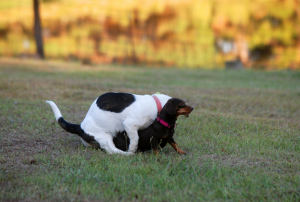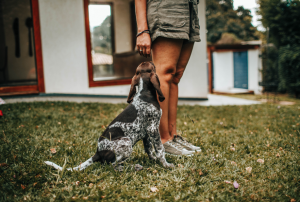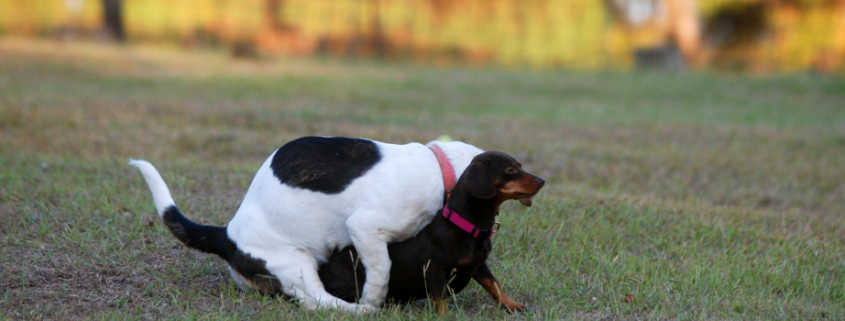Ask Crystal: Stop Do(ing) the Humpty Hump
Welcome to “Ask Crystal,” where you can ask your pet behavior questions! You can submit your question for Crystal at the bottom of the page!

Dear Crystal,
I have a 5-year-old Karelian Bear dog who constantly tries to dominate other large dogs by humping. I immediately pull him off and put him in a sit position, but he goes right back to the act at every opportunity. I’m afraid he’s going to initiate a fight at some point from this act. What should I do to discourage him from even attempting to do it?
Thank you,
Embarrassed Dog Dad
Dear Embarrassed,
Humping or what is also referred to as mounting can be an embarrassing behavior for humans and an irritating behavior to other dogs. There is a myriad of reasons why dogs hump objects, people and other dogs. If we can become at home ethologists and really investigate what precipitates the humping, we may be able to get to the root of the cause. We can, of course, address the humping in the moment but most behaviors have an underlying cause which needs to be addressed as well.
People often attribute humping to a dominance seeking behavior. First, it’s helpful to understand that dominance is not a personality trait. It is a fluid relationship between two animals established by force/aggression and submission to determine who has priority access to resources such as locations, food, toys, mates, etc. I doubt the bed or toys a dog likes to hump is viewed as competition for resources.
The other issue with labelling a behavior as dominance is how some people may respond to that behavior. If a person feels their dog is dominant, they may then try to put the dog in line with intimidation or making the dog follow very stringent rules which cut back on the dog’s ability to make choices. This in turn can cause stress and can damage the human dog relationship.
Is it possible that this is some sort of status move on your dog’s part? One study of dog-dog play in a day care setting found humping behavior more often associated with play and affiliative behaviors rather than with aggression and submission as would be expected with status seeking. It is often a way for play mates to initiate play or to test the bonds of friendship by seeing how much annoying behavior a friend will put up with.
Mounting can be a part of a series of behaviors which are associated with aggression such as frontal body posture, direct stares, high tail position, and standing over. By itself, mounting is not an aggressive behavior or status behavior. There will be other accompanying behaviors to indicate status seeking. It could be related to control or a challenge type of behavior but in those situations, we would again see those accompanying behaviors.
It is always a good idea to consider a dog’s breed when look at behavior. What the dog was created for will impact its behavior. It sounds like this breed is used to working independently and can be testy with other dogs. A broad generalization of the breed says that they can be suspicious of other animals.
Humping is most often caused by stress, anxiety or excitement. This is why we often see this type of behavior in dog parks. Meeting new dogs can be stressful and/or exciting. Without seeing your dog interact with other dogs, I cannot say which is causing it. He could be intimidated by large dogs and therefore stressed. If he doesn’t hump smaller dogs and plays with them as well, that may indicate some discomfort with larger dogs. If he wasn’t around other dogs much as a puppy or was with smaller dogs, this can influence his behavior. Maybe there is some social anxiety or discomfort in the setting in which the behavior occurs. Or he could be really excited to play with other dogs. Maybe he is the type of dog prone to over arousal in play situations.
It is a normal social behavior and if it is brief and not persistent it is generally not that big of a deal. If the dog is quite obsessed with attempting to hump, that is going to be problematic in some cases. Some dogs could care less if the other dog is constantly humping them but I usually try to separate them regardless as it can be quite oppressive for the humpee. A lot of dogs are going to offer a correction for a dog trying to hump. Usually, they will quickly hip check the dog to move out of the way, but they may escalate the corrections if your dog persists. Then the other part of the equation is how he takes the corrections. A dog should see the correction and stop his behavior before it escalates into higher level corrections which can cause altercations. Lower-level corrections may look like staring, freezing, lift lips, growls and air snaps. If he doesn’t stop after low level corrections, he may be socially awkward and need to learn signals with the help of a patient dog and you. He could be ignoring the signals on purpose because he doesn’t care and he wants to antagonize the other dog.
First, if we can identify the situations that cause the behavior, we should work to avoid those situations for the time being. For example, if the behavior is occurring at dog parks, stop going to dog parks or try going at less busy times. If it happens while you are on walks, stop allowing him to greet other dogs, especially because on leash greetings are especially stressful for many dogs. If someone is coming over with their dog, have him crated or behind a baby gate if he tends to hump that dog.
If he is not neutered and you are not planning on breeding him, neutering could solve the issue. There have been studies which indicate that found a 50% improvement in mounting behavior in 60% of dogs and 90% improvement in 40% of dogs after neutering.
The extent that you may see improvement in his behavior after neutering will be impacted by how long he has been allowed to practice this behavior. Behaviors which are caused by hormones and other medical causes can become learned behaviors if we allow the dog to continue to practice the behavior. Which is why we do not want to allow him to practice the behavior regardless of whether you plan to neuter or not.
Set your dog up with a friend’s tolerant dog that is willing to work with you. Tolerant meaning a dog that does not have a short fuse and won’t react aggressively if your dog does try to mount them. I would suggest a neutral fenced in yard so neither dog has the home advantage. If there isn’t a neutral yard, use your friend’s yard over your own so territory is not playing into it for your dog.
You can usually tell when a dog is starting the process of trying to mount the other dog. They often position themselves towards the rear and start to wrap their paws around the other dog. They also will often place their head on the other dog’s shoulder prior to mounting.
Different dogs try to hump at different times. Some dogs start from the introductions, some as play starts to escalate and arousal is ramping up. I had one dog that I could tell wanted to hump my dog but he waited until she was tired and lying down as that is the only way he could catch her.
Interrupt as soon as you see the beginnings of the attempts to mount. If you can interrupt before he is fulling engaged, it will be easier to stop. Start with trying to use body blocking at those initial attempts to begin mounting. You can lean forward or step in front of the dog to block the space and make him back off. Body blocking probably won’t work with the very determined mounter though.
Let your dog drag a light line or a tab which is basically a short line on the collar. This will make it safer to remove your dog from the other dog. If body blocking is not working, use time outs to remove your dog from the situation. Cheerfully say “oops” and walk your dog away. Your friend should hold onto their dog if needed to keep it from coming over. Stand off to the side with your dog until you can see them calm down and then let them interact again. We don’t want to yell or get angry as that will increase your dog’s stress level and make the behavior worse since it is often stress related.
With enough time outs, the dog should eventually give up on his mounting attempts at least for that session. You will likely need to repeat the training sessions with that dog several more times but hopefully each time with less and less interruptions.
Some additional training which you may find helpful is the Say Please protocol. This protocol asks the dog to perform a behavior such as sit, down, target before he gets anything that he wants such as food, petting, treats, toys, going outside. All of the good stuff comes from asking you politely. This program helps create a more responsive dog and reminds him that it is in his best interest to listen to you. If he has anxiety, rules and routine often help the anxious dog because they know what is expected and what comes next.
 Teach your dog an attention cue like Watch Me so you can get his focus away from other dogs. Teach a call away cue so you can practice calling him away after he sniffs and greets another dog and before he starts to hump. You can also use incompatible behaviors like sits or downs when you see the behavior about to occur to redirect him. This will also get him back in his thinking brain which is important if the mounting is related to over arousal. Since mounting is often associated with over arousal work on relaxation with the Overall Relaxation Protocol or Clothier’s Really Real Relaxation.
Teach your dog an attention cue like Watch Me so you can get his focus away from other dogs. Teach a call away cue so you can practice calling him away after he sniffs and greets another dog and before he starts to hump. You can also use incompatible behaviors like sits or downs when you see the behavior about to occur to redirect him. This will also get him back in his thinking brain which is important if the mounting is related to over arousal. Since mounting is often associated with over arousal work on relaxation with the Overall Relaxation Protocol or Clothier’s Really Real Relaxation.
If your dog tries to hump every dog at the dog park, then we can safely assume that situation is too much for him. Many dogs are actually somewhat overwhelmed and/ or stressed by dog parks. If he likes playing with other dogs, a better alternative is a play date with a dog he knows well. Dog daycares often have the same dogs playing every week. Dog usually prefer to only play with one other dog and they almost always have a play mate they prefer over the others. He also doesn’t have to play with other dogs at all. Some dogs just aren’t into other dogs and that is ok. It’s better to just not have him interacting with dogs than trying to force it if he doesn’t like it.
Until next time,
Crystal







